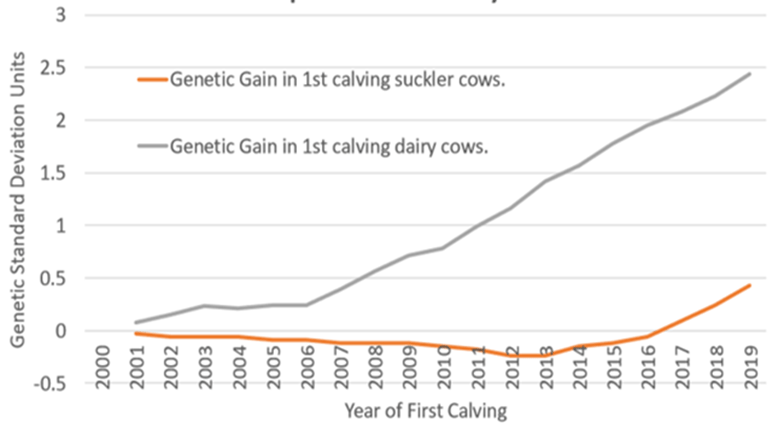Saturday 31st Oct was the final target date for herds participating in BDGP I (2015-2020). Herds were required to have the equivalent to 50% of their reference number in genotyped 4 or 5-star females. While the final numbers will not be known until after the 24th November genetic evaluation, the vast majority of the 22,500 participating herds look on course to meet the final 31st Oct 50% target.
Background
The Beef Data & Genomics Programme (BDGP) was launched in May 2015 by the Department of Agriculture Food & the Marine (DAFM) as part of its 2015-2020 EU Rural Development Programme (RDP). The objective was to increase the sustainability of the Irish national suckler herd through:
- Data collection (calf quality and docility, cow milk scores, carbon navigator etc.)
- The application of genotyping as a new technology in beef breeding.
- Increasing the Replacement Index nationally with individual herd targets.
This data collection and particularly the widespread application of genomics significantly increased the reliability of the Euro-Star Indexes, helping farmers to select breeding animals with more confidence as they worked towards the replacement female targets set out as part of BDGP (20% in 2018 and 50% in 2020). Over 1.8 million beef animals have been genotyped over the course of the BDGP.
Impact of BDGP
So has the BDGP succeeded in its goal of introducing higher Replacement Index females into the national herd and what impact has the introduction of these animals had? The answer to the first part of this question is a clear ‘Yes’. Analysis was carried out on the rates of genetic gain in the national dairy and suckler herds (Figure 1). It looked at the genetic merit of first calvers into both the suckler (Rep Index) and dairy (EBI) herds over the last 20 years.

While the genetic merit of the suckler herd is well behind that of the dairy herd (EBI was introduced 10-15 years earlier), the rate of gain is now on a par. This change has only come about in the last 4-5 years. In fact, at the start of the decade the genetic merit of the suckler herd was actually in decline.
So, what has been the impact of BDGP on the performance of the suckler herd? While it may be too early to analyse the performance of females born as a result of improved breeding decisions through BDGP, we can look at the performance of older suckler cows. Analysis was carried out by Dr. Alan Twomey, Teagasc on suckler cows born in 2012 and 2013. Cows were divided into three groups based on their Replacement Indexes – Very High, Average and Low. The performance of the cows themselves and their progeny was then compared (Table 1).

The ‘Very High’ group had the best fertility and weaning performance and although carcass weights were marginally lower, the progeny were slaughtered 5 days younger. Increasing the average Replacement Index of the national suckler herd will be fundamental to improving key efficiency metrics.
The 2020 beef calving statistics show BDGP herds significantly outperforming those not participating in the programme (Table 2). BDGP herds had 9 days shorter calving interval with heifers calving on average 1.6 months younger (approx. 50 days).

The benefits of the BDGP will only be fully realized in the coming years. As more high Replacement Index females calve down and mature in the national suckler herd, further improvements can be made in critical Key Performance Indicators (KPI’s) like calves/cow/year, age first calving and age at slaughter. With ever increasing scrutiny on the environmental impact of livestock farming and in particular suckler beef production, it is critically important that the Irish suckler herd reduces its CO2 emissions per kg of beef produced by improving the aforementioned KPI’s. Continued data recording, genotyping and introduction of higher genetic merit animals into the herd will be central to achieving this.
